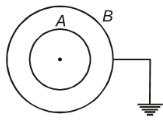The figure shows some of the equipotential surfaces. Magnitude and direction of the electric field is given by

1. 200 V/m, making an angle with the x-axis
2. 100 V/m, pointing towards the negative x-axis
3. 200 V/m, making an angle with the x-axis
4. 100 V/m, making an angle with the x-axis

An air capacitor of capacity is connected to a constant voltage battery of 12 V. Now the space between the plates is filled with a liquid of dielectric constant 5. The charge that flows now from battery to the capacitor is
1. 120
2. 699
3. 480
4. 24
A and B are two concentric metallic shells. If A is positively charged and B is earthed, then electric


1. Field at common centre is non-zero
2. Field outside B is nonzero
3. Potential outside B is positive
4. Potential at common centre is positive
1. \(\frac{\sigma}{2 \varepsilon_0} 2-\sqrt{3} R \)
2. \(\frac{\sigma}{2 \varepsilon_0} 2+\sqrt{3} R \)
3. \(\frac{\sigma}{2 \sigma_0} \sqrt{3}-\sqrt{2} R\)
4. \(\frac{\sigma}{2 \varepsilon_0} \sqrt{3}+\sqrt{2} R\)
An elementary particle of mass m and charge e is projected with velocity v at a much more massive particle of charge Ze, where . What is the closest possible approach of the incident particle ?
1.
2.
3.
4.
In the circuit shown in the figure, the energy stored in \(6~\mu\text{F}\) capacitor will be:

| 1. | \(48 \times10^{-6}~\text{J}\) | 2. | \(32 \times10^{-6}~\text{J}\) |
| 3. | \(96 \times10^{-6}~\text{J}\) | 4. | \(24 \times10^{-6}~\text{J}\) |
Four equal charges Q are placed at the four corners of a square of each side is ‘a’. Work done in removing a charge – Q from its centre to infinity is
(1) 0
(2)
(3)
(4)
Two spheres of radius a and b respectively are charged and joined by a wire. The ratio of the electric field at the surface of the spheres is
(1) a/b
(2) b/a
(3) a2/b2
(4) b2/a2
An electron of mass m and charge e is accelerated from rest through a potential difference V in vacuum. The final speed of the electron will be
(1)
(2)
(3)
(4)
The dimension of (1/2) : permittivity of free space; E: electric field) is
(1) MLT–1
(2) ML2L–2
(3) ML–1T–2
(4) ML2T–1






